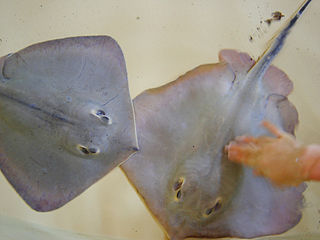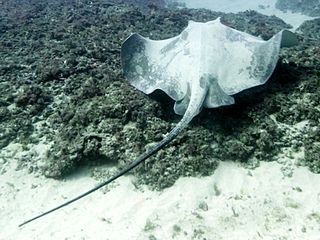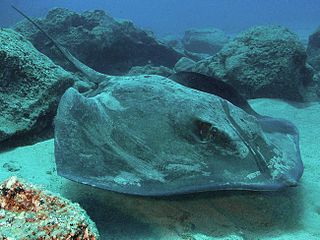
The short-tail stingray or smooth stingray is a common species of stingray in the family Dasyatidae. It occurs off southern Africa, typically offshore at a depth of 180–480 m (590–1,570 ft), and off southern Australia and New Zealand, from the intertidal zone to a depth of 156 m (512 ft). It is mostly bottom-dwelling in nature and can be found across a range of habitats from estuaries to reefs, but also frequently swims into open water. The largest stingray in the world, this heavy-bodied species grows upwards of 2.1 m (6.9 ft) across and 350 kg (770 lb) in weight. Its plain-colored, diamond-shaped pectoral fin disc is characterized by a lack of dermal denticles even in adults, and white pores beside the head on either side. Its tail is usually shorter than the disc and thick at the base. It is armed with large tubercles and a midline row of large thorns in front of the stinging spine which has the dorsal and ventral fin folds behind.

The bluespotted stingray, also known as bluespotted maskray or Kuhl's stingray, is a species of stingray of the Dasyatidae family. It was recently changed from Dasyatis kuhlii in 2008 after morphological and molecular analyses show that it is part of a distinct genus, Neotrygon. The body is rhomboidal and colored green with blue spots. Maximum disk width is estimated 46.5 centimeters (18.3 in). It is popular in aquaria but usually not distinguished from the bluespotted ribbontail ray. The ribbontail has a rounded body, is a brighter green with brighter blue and more vivid spots, but the bluespotted stingray is larger. The stingray's lifespan is estimated thirteen years of age for females and ten years for males. The bluespotted stingray preys on many fish and small mollusks. The bluespotted stingray is also generally found from Indonesia to Japan, and most of Australia. The bluespotted stingray is also targeted by many parasites such as tapeworms, flatworms, and flukes.

The red stingray is a species of stingray in the family Dasyatidae, found in the northwestern Pacific Ocean off Japan, Korea, and China, and possibly elsewhere. It primarily inhabits shallow, sandy habitats close to shore, and has been known to enter brackish water. The red stingray has a diamond-shaped pectoral fin disc and gains its common name from its bright orange-red underside; there may also be patches of orange at various spots on its upper surface. Most individuals are no more than 1 m (3.3 ft) long.

The diamond stingray is a species of stingray in the family Dasyatidae. It is found in the coastal waters of the eastern Pacific Ocean from southern California to northern Chile, and around the Galápagos and Hawaiian Islands. This bottom-dweller generally inhabits sandy or muddy flats near rocky reefs and kelp forests, to a depth of 30 m (98 ft), though off Hawaii it may range considerably deeper. As its common name suggests, this species has an angular, diamond-shaped pectoral fin disc that is plain brown or gray above, with rows of tubercles along the midline and on the "shoulders". The long, whip-like tail has both dorsal and ventral fin folds, which distinguish this ray from the closely similar longtail stingray (D. longa). It typically grows to 1 m (3.3 ft) across.
The Niger stingray or smooth freshwater stingray, Dasyatis garouaensis, is a species of stingray in the family Dasyatidae, native to rivers in Nigeria and Cameroon. Attaining a width of 40 cm (16 in), this species can be distinguished by its thin, almost circular pectoral fin disk, slightly projecting snout tip, and mostly smooth skin with small or absent dermal denticles. The Niger stingray feeds on aquatic insect larvae and is ovoviviparous. The long stinging spine on the tail of this ray can inflict a painful wound. It has been assessed as Vulnerable by the International Union for Conservation of Nature (IUCN), as its numbers are declining in some areas and it faces heavy fishing pressure and habitat degradation.

The longnose stingray is a species of stingray in the family Dasyatidae, native to the western Atlantic Ocean from the southern Gulf of Mexico to Brazil. Found in coastal waters no deeper than 36 m (118 ft), this demersal species favors muddy or sandy habitats. The longnose stingray is characterized by its angular, rhomboid pectoral fin disc, moderately projecting snout, and whip-like tail with a dorsal keel and ventral fin fold. It typically grows to 1.25 m (4.1 ft) across and is brownish above and light-colored below.

The Mekong freshwater stingray, Hemitrygon laosensis, is a species of stingray in the family Dasyatidae, restricted to the Mekong and Chao Phraya Rivers in Laos and Thailand; the occurrence in Chao Phraya is considered an introduction. Measuring up to 62 cm (24 in) across, this ray has an oval pectoral fin disc, a tail with both upper and lower fin folds, and a midline row of spine-like dermal denticles. A characteristic feature of this species is its bright orange underside. The Mekong freshwater stingray preys on invertebrates and is aplacental viviparous. It has been assessed as Endangered by the International Union for Conservation of Nature (IUCN), as it is threatened by overfishing and habitat degradation.
The Brazilian large-eyed stingray, Dasyatis marianae, is a species of stingray in the family Dasyatidae. Endemic to northeastern Brazil, adults of this species inhabit shallow coral and sandstone reefs while the young are also found near beaches and in estuaries. This stingray measures up to 40 cm (16 in) across and can be identified by its large eyes, equally long fin folds above and below the tail, and distinctive coloration consisting of various dark brown markings on a yellowish-brown background above, and two pairs of dark brown blotches on a white background below. Reproduction is aplacental viviparous, with females giving birth to one young at a time, twice a year, and using sandbanks as nursery areas. The Brazilian large-eyed stingray is collected by artisanal fisheries and for the ornamental fish trade; the International Union for Conservation of Nature (IUCN) does not have sufficient data to assess its conservation status.

The bluntnose stingray or Say's stingray is a species of stingray in the family Dasyatidae, native to the coastal waters of the western Atlantic Ocean from the U.S. state of Massachusetts to Venezuela. It is a bottom-dwelling species that prefers sandy or muddy habitats 1–10 m (3.3–32.8 ft) deep, and is migratory in the northern portion of its range. Typically growing to 78 cm (31 in) across, the bluntnose stingray is characterized by a rhomboid pectoral fin disc with broadly rounded outer corners and an obtuse-angled snout. It has a whip-like tail with both an upper keel and a lower fin fold, and a line of small tubercles along the middle of its back.
The pincushion ray or thorny freshwater stingray is a little-known species of stingray in the family Dasyatidae, found in the rivers and lakes of West and Middle Africa. A heavy-bodied ray measuring up to 1.2 m (4 ft) across, this species can be distinguished by its rounded pectoral fin disk, reduced or absent stinging tail spine, and—in adults—numerous stout thorns covering its back and tail. In lieu of a long tail spine as in other stingrays, the pincushion ray employs these thorny denticles in defense. Seldom encountered since it was originally described, this species has been assessed as Endangered by the International Union for Conservation of Nature (IUCN).

The broad stingray, also known as the brown stingray or Hawaiian stingray, is a species of stingray in the family Dasyatidae. The predominant species of stingray in the inshore waters of the Hawaiian Islands, this benthic fish typically inhabits sandy or muddy flats at depths greater than 15 m (49 ft). Usually growing to 1 m (3 ft) across, the broad stingray has a wide, diamond-shaped pectoral fin disc with a protruding snout tip and a long tail with a ventral fin fold. At night, this species actively forages for bottom-dwelling invertebrates and bony fishes, often near the boundaries of reefs. Reproduction is aplacental viviparous. As substantial threats to its population do not seem to exist, the International Union for Conservation of Nature has listed this species as least concern.

The common stingray is a species of stingray in the family Dasyatidae, found in the northeastern Atlantic Ocean and the Mediterranean and Black Seas. It typically inhabits sandy or muddy habitats in coastal waters shallower than 60 m (200 ft), often burying itself in sediment. Usually measuring 45 cm (18 in) across, the common stingray has a diamond-shaped pectoral fin disc slightly wider than long, and a whip-like tail with upper and lower fin folds. It can be identified by its plain coloration and mostly smooth skin, except for a row of tubercles along the midline of the back in the largest individuals.

The roughtail stingray is a species of stingray in the family Dasyatidae, with separate populations in coastal waters of the northwestern, eastern, and southwestern Atlantic Ocean. This bottom-dwelling species typically inhabits sandy or muddy areas with patches of invertebrate cover, at a depth of 15–50 m (49–164 ft). It is seasonally migratory, overwintering in offshore waters and moving into coastal habitats for summer. The largest whip-tail stingray in the Atlantic, the roughtail stingray grows up to 2.6 m (8.5 ft) across and 360 kg (800 lb) in weight. It is plain in color, with an angular, diamond-shaped pectoral fin disc and a long, whip-tail tail bearing a subtle fin fold underneath. The many thorns on its back and tail serve to distinguish it from other stingrays that share its range.

The smalleye stingray is a large species of stingray in the family Dasyatidae, measuring up to 2.2 m (7.2 ft) across. Rare but widely distributed, it is found in the Indo-Pacific from Mozambique to India to northern Australia. This species may be semi-pelagic in nature, inhabiting both deeper waters and shallow coastal reefs and estuaries. It is characterized by a diamond-shaped pectoral fin disc much wider than long, a tail that is broad and flattened in front of the spine but whip-like behind, and large white spots over its back.
The giant stumptail stingray, Dasyatis gigantea, is a species of stingray in the family Dasyatidae, known from only two specimens collected from the Peter the Great Bay in the Sea of Japan. This large species is characterized by rhomboid pectoral fin disc wider than long, a relatively long snout, and a short, blunt tail. The International Union for Conservation of Nature (IUCN) has listed this species as Data Deficient and recommended further study.

The daisy stingray, Dasyatis margarita, is a little-known species of stingray in the family Dasyatidae, found in shallow waters along the coast of West Africa. This species typically grows to 60 cm (24 in) across and has a rounded pectoral fin disc and a wide band of dermal denticles over its back. It is characterized by a greatly enlarged, nacreous denticle in the middle of its back called a "pearl spine"; this feature is shared with the similar but much smaller pearl stingray, which has often been confused with this species. The daisy stingray feeds mainly on crustaceans and exhibits aplacental viviparity, with litters of 1–4 young. Heavily pressured by fisheries and possibly habitat degradation, this once-common species is declining and has been assessed as Endangered by the International Union for Conservation of Nature (IUCN).
The smalleye whip ray is an obscure species of stingray in the family Dasyatidae. It is known only from a single specimen collected off Taiwan and assigned to the genus Dasyatis by J.T.F. Chen in 1948. In 1982, Leonard Compagno and Tyson Roberts moved it to the genus Himantura based on its apparent lack of a tail fold. In 2006, B. Mabel Manjaji-Matsumoto and Peter Last determined that the type specimen had been lost since Chen's description and that no further specimens have emerged since. Therefore, they considered this species to be a nomen dubium, perhaps conspecific with Dasyatis acutirostra.














